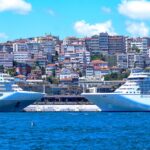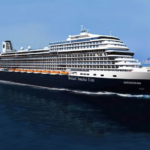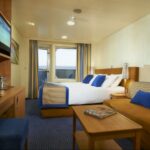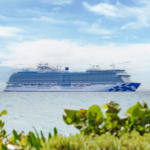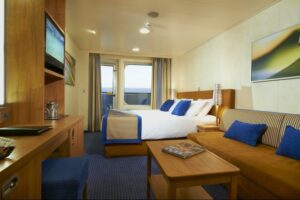Cruise ships offer a luxurious experience, sailing through the oceans of the world in style. But with the big waves and rough conditions out at sea, do they ever tip over? If you’ve been wondering this, you’ve come to the right place!
How do cruise ships not tip over? Cruise ships are designed to not tip over. Even a large mass, like a cruise ship, will stay afloat due to the principle of buoyancy – the mass is equal to the upward pressure of the water. To minimize rocking, it keeps a low center of gravity by keeping heavy equipment below deck and using ballast tanks.
If you’ve never taken a cruise before, it’s understandable that you might feel a little anxious. If you’re concerned or just curious about how cruise ships keep from tipping over, read on!
Also, if you want to get off the cruise for a break, an inflatable paddle board is perfect for when you’re docked:
Click here to see it on Amazon.
How Do Cruise Ships Not Tip Over?
The first step to explaining how cruise ships don’t tip over is to look at how they stay afloat.
Let’s face it; a cruise ship is an ungainly-looking affair. Unlike, say, a sleek and fast motorboat or sailboat, a cruise ship seems to sit heavy and clumsily on the water.
To give you an idea, the world’s largest cruise ship, Royal Caribbean’s Symphony of the Seas, is 1,188 feet long by 215 feet wide (360 meters by 65 meters). It has a gross tonnage of 228, 081, 18 decks, and can carry about 8,000 people.
Given those dimensions, it’s not surprising that cruise ships are often called “floating cities.” They are just that big and have so many people on board.
Basically, objects at sea, be they huge cruise ships or chunks of driftwood, float because of the principle of buoyancy. The buoyancy of an object on the water depends on its density. If the object is denser than water, then it will sink. If, however, it is less dense than water, it will float.
When something that can float is placed on the water, its weight displaces an equivalent amount of water, pushing the object downwards. What keeps it from sinking is an opposing upward force or pressure from the water. This upward force weighs the same as the water that was displaced, keeping it from sinking completely. The greater the weight of an object, in this case, a ship, the lower it will sit in the water.
To learn more about how cruise ships do not tip over, see the below video:
Cruise Ships Are Designed for Stability and Smooth Sailing
Cruise ships are designed to minimize the dangers of tipping over. They are specifically constructed to be as buoyant as possible. Their hull and body are made of very lightweight and sturdy materials, and they often use what’s called a displacement hull, which is wide with a deep bottom.
If you look at the hull of a cruise ship, you will see that the displacement hull has round edges to minimize drag and make it move smoothly on the water, increasing the vessel’s stability. The passengers get a smooth ride as cruise ships rarely rock or sway as they move. This minimizes the chances of passengers feeling seasick too.
A cruise ship’s stability and buoyancy are also enhanced by keeping its center of gravity low. An object’s center of gravity is the average location where the weight of the object is concentrated. If the center of gravity of an object is stable, it helps to balance the entire thing. The lower the center of gravity of an object, the less lightly it is to tip over.
When it comes to cruise ships, you want the ship to have a low center of gravity as it keeps it stable in the water. A stable center of gravity is key to keeping the cruise ship upright and not tipping over.
If an object sits low on the water, the chances that it will tip over is lessened. To ensure that a cruise ship’s center of gravity is stable, the heaviest equipment is below the lower deck; this includes the engines, fuel tanks, waste tanks, and the tanks containing drinking water.
To stabilize the ship, there are also ballast tanks below deck. These contain water that can be pumped from both ends of the ship as needed to maintain its overall stability. These ballast tanks, in effect, allow the weight of the ship to be controlled and stabilized. They control the weight of the ship and lower its center of gravity, keeping it stable.
The most dangerous threat to the stability of a cruise ship is the waves. Despite looking top heavy and like a strong wind would blow it over, most marine experts would say that it’s the waves that are the real threat.
“By itself, no wind can cause any ship to capsize,” said Neill Conroy of the Nautical Institute during an interview with Express [1]. “However, the waves induced by a strong wind that lasts for an extended period can certainly cause a small ship to capsize if the waves strike the ship broadside (or nearly so) under the right circumstances.”
A rogue wave could also cause a cruise ship to tip over. This wave is twice the size of surrounding waves that comes in another direction than the rest of the waves and winds in the area. However, a rogue wave is an extremely rare occurrence.
Because of this threat, cruise ships are outfitted with weather routing services, ensuring that they avoid any potential rough weather or circumstances that might threaten their stability.
To learn more about the ballasts cruise ships use to prevent rocking and tipping over, see the below video:
Conclusion – How Do Cruise Ships Not Tip Over?
Cruise ships do not tip over for several reasons:
- Even a large mass, like a cruise ship, will stay afloat due to the principle of buoyancy – the mass is equal to the upward pressure of the water.
- It also keeps a low center of gravity by keeping all of its heaviest equipment below deck.
- It uses ballasts to pump water from either side of the ship to counter the waves and minimize rocking.
While ocean voyages may have a history of being perilous, the design and build of ocean-going craft benefit from a history of scientific and engineering breakthroughs. These breakthroughs enable a better understanding of how things float and how best to ensure that ships can withstand the unpredictability of the ocean. All this comes into play in the design and manufacture of today’s cruise ships.
No matter how massive a cruise ship might look on the outside, you can rest assured that inside and out, it can weather almost all of the worst conditions at sea.
Even so, it doesn’t have to endure bad conditions because it has the benefit of technology that maps out the route in front of it and keeps it informed about potentially hazardous conditions such as extreme weather. A cruise ship will not risk itself or its passengers by going into a circumstance where it will tip over.
Related reading:
Which Deck Is the Best on a Cruise Ship?



